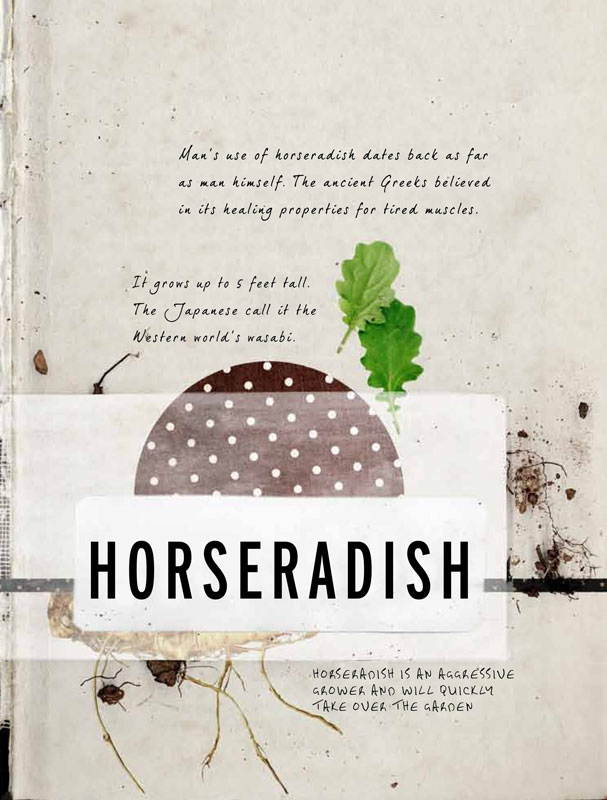
Horseradish packs the most amazing flavor punch and, although it’s thought to have originated in central Europe, to me, it is the quintessential British vegetable. Some people argue it’s not a vegetable but more a spice or accompaniment, but it is my true love, and a complement for everything.
RECIPES
HORSERADISH & CELERIAC SALAD WITH SUGAR & SALT CURED BEEF
HORSERADISH & TARRAGON MUSTARD
HORSERADISH CREAM WITH A JOINT OF BEEF & ME NAN’S YORKSHIRE PUDDINGS
Well, one story is that the name horseradish comes from the Germans, who call it “meerrettich” or sea radish as it grows near the sea. Somewhere along the line the English began to mispronounce it as “mare-radish” and from there it wasn’t much of a stretch to horseradish.
Man’s use of horseradish dates about as far back as man himself The ancient Greeks believed in its healing properties for tired muscles, and it is central to the celebration of Passover for Jewish people, being listed as one of the “five bitter herbs” they are instructed to eat during this holy time, along with cilantro, romaine lettuce, horehound and nettles. The Japanese call it the Western world’s wasabi, and they’re not far wrong as it is a relative of both wasabi and mustard, which is where it gets it’s vicious, delicious bite from.
Horseradish’s best match has to be beef. Beef without horseradish is like Romeo without Juliet. The two are just meant to be together, married forever. It’s not as suited to other meats, although it can add a nice heat and sweetness to sauces and gravies. Where it really shines is with fish and vegetables. It’s beautiful with parsnip, sharing that same mustard flavor. It’s traditionally served in Russia and Eastern Europe with beets and enhances the natural sweetness of turnips and carrots. I think it’s a highly underrated accompaniment for other vegetables. It’s classic use in Scandinavia is to cure salmon and white cod, and it is highly complementary to any cured fish. Horseradish crème fraîche or just fresh horseradish grated over right before serving is amazing.
It’s leaves are often overlooked for culinary use, but you can use them as you would any mustardy leaf You may think that the flavor would be too intense because of the heat, but it’s really lovely. Use them sautéed and served on their own as an accompaniment or add at the last minute to Asian dishes.
Horseradish is a root vegetable, like carrot, beets and parsnip, and is what’s known as a rhizome, which means that it produces roots that stretch out horizontally. When you pull the plant from the ground, these roots snap off and remain, continuing to grow and eventually producing another horseradish plant. Ginger and sunchokes reproduce in the same way. It’s a delicate process, and this is why most of the world’s horseradish crop is still harvested by hand.
You should be able to find fresh horseradish all year round, though it does better in the colder weather than warm. It’s not a big fan of summer and struggles a bit. When growing, it does need quite a bit of water but it is still quite a hardy plant. When you’re growing your own, let it get to the size of a small parsnip before harvesting.
The recipes included here use what seems like quite a lot of horseradish. To use fresh horseradish, simply use a vegetable peeler to remove the skin from a small section. For the best result, only peel as much as you need to use, as this will help the horseradish to keep for up to a week. Use a Microplane (or fine grater) and grate the horseradish over the top of the dish immediately before serving.
One word of warning when grating fresh horseradish: I would highly recommend wearing gloves. And goggles. Even swimming goggles. You may feel a bit of a fool, but it’ll save you plenty of tears. At one of my first jobs at Warren House in London, my head chef, Mike Taylor, made me grate about a kilo of fresh horseradish. It was ten times worse than chopping onions. My mouth and nostrils were burning. Tears were streaming down my face. Unbeknown to me, he stood behind a curtain laughing at me! I managed to grate it all, but it wasn’t very pleasant.
Another tip is if you realize you have too big a root and you won’t be able to use it before it’s past its best, cut it into small pieces, wrap it in foil and freeze. Thaw as you need and use as you would the fresh stuff Otherwise, I am not opposed to ajar of good-quality pre-prepared horseradish. I know it seems controversial to say, but you have to think that these products were preserved in their prime, so I’d always choose the product that is of better quality and has better flavor. Sometimes this can be the canned, frozen or preserved version. I prefer to use something that has been captured at the peak of its season than to make do with the fresh version that is either out of season or past it’s best. When deciding which canned or pre-prepared variety to choose, my rule of thumb is to look at the list of ingredients on the side and choose the one with the least ingredients (for example, only horseradish, vinegar, salt and sugar), the one with the highest percentage of horseradish and without any preservatives as the vinegar is the preservative. It really shouldn’t need any chemicals added.
I’ve included the recipe for my nan’s roast beef with Yorkshire pudding (see recipe), and I insist that you make the horseradish cream that goes with it.
HORSERADISH & CELERIAC SALAD WITH SUGAR & SALT CURED BEEF
SERVES 4
This salad is simply a rémoulade. You’ve probably seen it somewhere before, but here I’ve combined the earthy/peppery taste of the horseradish, the earthy sweetness of the celeriac and the freshness of the apple to make a mesmerising dish, great with not only cured meats but also most seafood and chicken.
1 CUP SEA SALT
½ CUP UNREFINED LIGHT BROWN SUGAR
½ TEASPOON SICHUAN PEPPERCORNS
2 ALLSPICE BERRIES
1 STAR ANISE
6 JUNIPER BERRIES
1 POUND BEEF RUMP CAP, TRIMMED OF ALL FAT (ASK YOUR BUTCHER TO DO THIS FOR YOU)
1 CELERIAC (CELERY ROOT) (ABOUT 14 OUNCES) (PROBABLY THE WORLD’S MOST UNDERRATED VEG)
4, SMALL APPLES (MY FAVORITE ARE LITTLE NEW-SEASON GALA)
PINCH FINE SEA SALT
JUICE OF ½ LEMON
1 MEDIUM HANDFUL OF ITALIAN PARSLEY LEAVES CHOPPED
½ CUP MAYONNAISE
9 OUNCES PIECE OF FRESH HORSERADISH, PEELED
EXTRA VIRGIN OLIVE OIL, FOR DRIZZLING
3 TABLESPOONS PARSLEY SHOOTS
BABY NASTURTIUM LEAVES (OPTIONAL)
BROILED SOURDOUGH AND ROMESCO SAUCE (SEE RECIPE) (OPTIONAL)
For the sugar and salt cured beef, place the salt, sugar and spices in a mortar and coarsely grind. Place the beef on a tray, sprinkle over the salt cure and roll to coat well. Cover and refrigerate for 2 hours. Remove the beef and lightly wash, then pat dry. Heat a broiler or chargrill (griddle) pan to high and char the beef all over. Alternatively, seal in a hot skillet (with no oil added). Allow to cool, then thinly slice.
For the salad, thinly slice the celeriac and apple on a mandoline, then cut into thin strips. Toss with the salt. Allow to sit for 2 minutes. Mix in the lemon juice, parsley and mayonnaise. Grate in some horseradish (about one-third, depending on how peppery you like it), reserving some to garnish.
Place the salad onto a serving dish, layer over the slices of cured beef, drizzle with olive oil, grate over some horseradish and top with the parsley shoots and nasturtium leaves. Serve with the sourdough and romesco.
SIMPLE ROASTED PEPPERS TURNED INTO ROMESCO SAUCE
MAKES ABOUT 3 CUPS OF SAUCE
This recipe is a nice and easy way to roast peppers. For the romesco sauce, I add quince paste to give it a sweet and earthy flavor. The sauce goes great with all pork dishes and vegetables and is also lovely with crayfish, but is just as delicious as a simple dip.
5 RED PEPPERS (ABOUT 1 POUND 14 OUNCES)
⅓ CUP OLIVE OIL
2 SPRIGS OREGANO
2 SPRIGS THYME
SEA SALT AND FRESHLY GROUND BLACK PEPPER
Preheat the oven to 425°F. Place all the ingredients in a roasting tray and mix together. Roast for 40–50 minutes, shaking every 8 minutes or so until the peppers become soft and the skins are nicely browned. Take out of the oven, cover with foil and leave to rest for 10 minutes. This keeps the moisture within the peppers and makes them easier to peel. After 10 minutes, carefully peel and remove all the seeds. Add the roasted flesh to salads or I like to turn it into romesco.
1 POUND 5 OUNCES ROASTED PEPPER FLESH (NO SKIN OR SEEDS) (SEE RECIPE ABOVE)
⅓ CUP QUINCE PASTE
⅓ CUP ORGANIC RAW ALMONDS, BLANCHED IN BOILING WATER, THEN PEELED AND CHOPPED
1 GARLIC CLOVE
1 PINCH OF FENNEL SEEDS
1 PINCH OF CORIANDER SEEDS
1 PINCH OF NIGELLA SEEDS (ALSO KNOWN AS BLACK CUMIN OR KALONJI SEEDS)
1 PINCH OF CUMIN SEEDS
1 PINCH OF SUMAC
1 PINCH FINE SEA SALT
¾ CUP EXTRA VIRGIN OLIVE OIL
1½ TABLESPOONS CABERNET VINEGAR
Blitz the pepper flesh, quince paste, almonds and garlic to a purée in a food processor. Add the spices and salt and blitz again. Pour into a bowl, then fold in the oil and vinegar. It may require a little more vinegar to taste and some extra seasoning. This will keep well in the fridge for up to 1 week in an airtight container.
HORSERADISH & TARRAGON MUSTARD
FILLS 3 STANDARD PRESERVING JARS
Sometimes what appears to be the most complicated is usually the easiest. Our supermarket shelves have become stocked to the brim with food items that seem too tiresome or hard to make, so we find ourselves buying these things for convenience. Mustard is a prime example. Only a few years ago, I thought, “Mustard, geez that sounds hard to make!” But after looking at Stephanie Alexander’s recipe for grain mustard, I realized just how easy and non-time consuming it is to make mustard—and how much better the homemade stuff tasted. These traditional recipes and forgotten skills of cooking need preserving. This is my recipe, honed from the many times I’ve made it, and I can tell you that it’s a beauty. Once you’ve made it, you will not look to those jars on the supermarket shelf again.
2 CUPS YELLOW AND BROWN MUSTARD SEEDS
½ CUP HOT WATER
2½ OUNCES TARRAGON LEAVES, CHOPPED
½ CUP FINELY GRATED FRESH PEELED HORSERADISH
2 TABLESPOONS FINE SEA SALT
1½ CUPS APPLE CIDER VINEGAR
Blitz 1¼ cups of the mustard seeds in a spice grinder until a fine powder. Tip into a large bowl, add the remaining mustard seeds and the hot water and mix. Leave to sit for 5 minutes, then whisk in the remaining ingredients.
Transfer to a non-reactive container, cover with a damp tea towel and leave at room temperature for 2 days. Give it a stir each day, then transfer to preserving jars with lids. Store for 3 weeks before using. Store opened jars in the fridge for up to 3 months. Unopened jars will keep for years.
HORSERADISH WAFERS
MAKES ABOUT 20
A great simple snack to use as a base for a canapé or mix in with a salad for some crunch instead of croûtons.
¾ CUP FINELY GRATED PARMESAN
1 TABLESPOON ALL-PURPOSE FLOUR
½ TABLESPOON SESAME SEEDS
1¾ OUNCES PIECE OF FRESH HORSERADISH, PEELED AND FINELY GRATED ON A MICROPLANE
1 TEASPOON THYME LEAVES
15 TURNS OF WHITE PEPPER IN A MILL
Preheat the oven to 325°F. Grease two baking sheets with oil and line with parchment paper, trimmed to fit exactly.
Place the Parmesan, flour, sesame seeds, horseradish, thyme and pepper in a bowl and mix together.
Take a 2¾ inch diameter cutter and place on one of the trays. Sprinkle the Parmesan mixture into the cutter, covering the whole surface up to ⅛ inch thick. Repeat making wafers on the trays, leaving room in between each for spreading. Bake for 9–12 minutes or until golden brown (see Note). Once golden, slide the wafers off the tray and onto a surface to cool.
Store in an airtight container, layered between paper towels or parchment paper for up to 2 days.
Note The outside wafers will more than likely color up before the inside ones, so turn the tray around after 6–8 minutes and take off the outside wafers, then put the tray back in the oven so the rest can finish baking.
HORSERADISH CREAM WITH A JOINT OF BEEF & ME NAN’S YORKSHIRE PUDDINGS
SERVES 4 (WITH LEFTOVERS)
The horseradish amount you use for the cream is entirely up to you. The more you use, the hotter the cream, naturally. I like to keep some back and grate it over the whole dish at the end. Can I use pre-prepared horseradish I hear you ask? Go on then, but there ain’t nothing like afresh horseradish party.
9 OUNCES CRÈME FRAÎCHE
1 OUNCE PIECE OF FRESH HORSERADISH, PEELED AND FINELY GRATED ON A MICROPLANE
JUICE OF 1 LEMON
FINE SEA SALT AND FRESHLY GROUND BLACK PEPPER
LIGHT CREAM, FOR THINNING
4 POUNDS JOINT OF SIRLOIN
2 TABLESPOONS OLIVE OIL
SEA SALT AND FRESHLY GROUND BLACK PEPPER
¾ CUP SELF-RISING FLOUR, SIFTED TWICE
½ TEASPOON FINE SEA SALT
2 FREE-RANGE OR ORGANIC EGGS
1 GENEROUS CUP MILK
⅓ CUP LARD OR BEEF FAT (OR VEGETABLE OIL IF YOU’RE THINKING ABOUT YOUR WAISTLINE)
For the horseradish cream, whisk all the ingredients together. If it seems a little dry, thin with a little cream. If it seems a little wet, hang in a coffee filter or in cheesecloth in the fridge for a few hours.
For the joint of beef, preheat the oven to 400°F. Heat a large skillet over high heat for 1 minute, then add the oil. Add the beef and seal all sides. This should take 8 minutes or so. Once all the sides are browned, sit the beef on a wire rack placed inside a roasting tray. Season all sides with salt and pepper, then roast for 45–50 minutes for medium-rare. Take the beef out of the oven and check if its cooked. Insert a metal skewer into the fattest part of the meat, then remove and run it along your bottom lip—it should feel nice and warm. Cover with foil or a heavy cloth and rest for 10 minutes. Carve into thick slices to serve.
For the Yorkshire puddings, preheat the oven to 400°F. Place the flour and salt in a bowl and make a well in the center. Add the eggs and milk and whisk until smooth. Rest for 30 minutes. Fill a 6-holed muffin tray (with holes that are at least 3¼ inches in diameter by 1¼ inches deep) with 3 teaspoons of lard in each hole and place in the oven for 15–20 minutes. This is the most crucial part to making the yorkies rise. When the lard is hot, open the oven door and spoon in the batter until it reaches almost to the brim. It’s important to leave the tray in the oven so the lard doesn’t lose too much heat. Bake for 15 minutes, then turn down the heat to 375°F and cook for a further 15 minutes. They should be high and golden brown. Carefully take the tray out of the oven, turn the puds out and serve straight away with the carved beef and horseradish cream on the side.
1 Prepare horseradish cream. Season beef with salt and pepper on all sides and roast until medium rate.
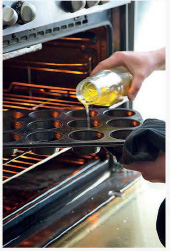
2 Place lard or pour oil into the holes of the muffin tin and place in oven for 15–20 minutes.
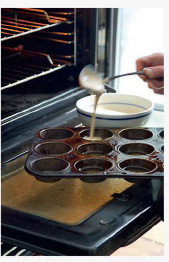
3 When oil is hot, open oven door and spoon in the batter until just below the brim.
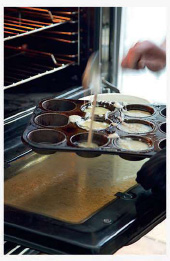
4 Continue with the remaining batter working quickly, with the oven door open so that the muffin tin and oil retain their heat.
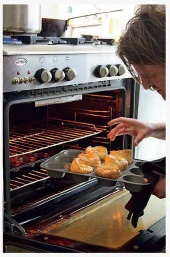
5 Cook puddings for a further 15 minutes until golden brown.
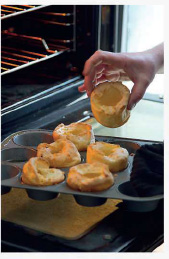
6 Remove yorkies and serve straight away with the carved beef and horseradish cream.